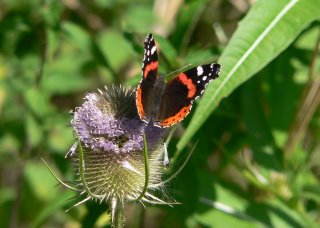One of the frustrations of not being able to bird of late has been watching Internet discussions postings about great birds that have come and gone across Warwickshire and nearby counties - a Wryneck near Solihull, a Bittern at Napton, Whooper Swans at Draycote blah blah blah.
So when the Great Skua at Draycote was kind enough to stay for more than a week I finally dug my bins out and headed off for a quick twitch.
Well, I found it, just. It couldn't have been more distant and I could never have found it without help, but there you go. A great big grey-brown blob in the middle of a reservoir. Can't understand what those twitchers get so worked up about sometimes!
31 December 2006
17 December 2006
Leam Valley - but where's winter?
After weeks and weeks without any birding at all, I got up early, wrapped up warm and... boiled.
OK, so it wasn't exactly hot at just over 1 degree C, but there just hasn't been a real bite in the air yet this year (or at least if there has I've been stuck in a heated office and missed it). Still, it was just nice to get out, even if no one told the birds I was coming, and it was cool enough to get a nice mist rising off the River Leam.
A trip round Leam Valley produced most of the regulars, including a nice number of Bullfinches (five in all), and up to five singing Song Thrushes. It was also nice to meet a fellow birder in the hide - that makes three of us who I know keep a regular (in my case currently less than regular) eye on the place.
I pressed on to Napton and found a large number of Coots (around 160), plenty of Common Gulls on the water (80 in all - they seem to be more numerous here than elsewhere in the winter months), and a Grey Wagtail - always a welcome flash of colour on a winter morning.
A pretty poor haul by normal standards, but like an ice cold beer to a thirsty man after more than a month without any birding.
OK, so it wasn't exactly hot at just over 1 degree C, but there just hasn't been a real bite in the air yet this year (or at least if there has I've been stuck in a heated office and missed it). Still, it was just nice to get out, even if no one told the birds I was coming, and it was cool enough to get a nice mist rising off the River Leam.
A trip round Leam Valley produced most of the regulars, including a nice number of Bullfinches (five in all), and up to five singing Song Thrushes. It was also nice to meet a fellow birder in the hide - that makes three of us who I know keep a regular (in my case currently less than regular) eye on the place.
I pressed on to Napton and found a large number of Coots (around 160), plenty of Common Gulls on the water (80 in all - they seem to be more numerous here than elsewhere in the winter months), and a Grey Wagtail - always a welcome flash of colour on a winter morning.
A pretty poor haul by normal standards, but like an ice cold beer to a thirsty man after more than a month without any birding.
12 November 2006
Fieldfare and Sky Lark by the score
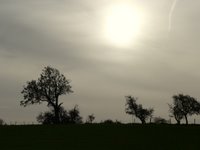 I have just enjoyed a beautiful morning walking around the fields near Radford Semele.
I have just enjoyed a beautiful morning walking around the fields near Radford Semele.The hedgerows, fields and skies were full of finches, buntings, gulls, crows, thrushes and plenty more besides as a low pale sun battled to break through.
Early highlights included a Goldcrest in my garden and then a female Bullfinch and a couple of Reed Buntings not far away. At the pond I found a couple of Mallards plus a Moorhen, but it was as I started to walk up towards Crown Hill that things got very interesting indeed.
First one, then half a dozen then perhaps 50 or more Sky Lark flew over in small and not-so-small groups - at one point I counted 30 in the air at once. This would make it easily the largest Sky Lark count I have made here or indeed anywhere else.
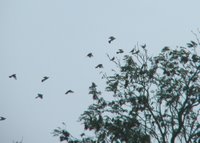

At the bottom of the hill I had seen 19 Fieldfare fly overhead, but at the top I was confronted with in excess of 160 of them, some feeding on the ground must most flitting from tree to tree in large groups. Again, this is a pretty decent number to find at any time.
On the way back down the hill I counted perhaps a dozen Yellowhammers, a few Redwing, more than a dozen Meadow Pipits and a solitary Common Gull (a sure sign that winter is in Radford Semele).
5 November 2006
Sparrowhawks at Leam Valley
The Sparrowhawk is a common but elusive bird of prey which relies on the element of surprise in its attack. It is principally a woodland bird (although fairly common now in gardens and parks), able to twist fast and low through the undergrowth in order to surprise its prey - not just sparrows as it happens, but any suitably sized bird. For stealth, speed and manouverability in tight spaces it is unsurpassed.
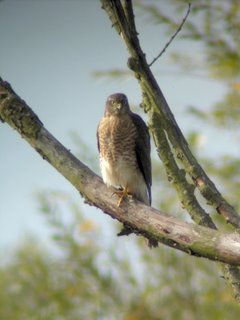 The upshot of this lifestyle is that the Sparrowhawk is rarely seen, and so generally under recorded. Which makes today's walk around Leam Valley all the more unusual, with five (yes, count them, five) separate Sparrowhawk sightings.
The upshot of this lifestyle is that the Sparrowhawk is rarely seen, and so generally under recorded. Which makes today's walk around Leam Valley all the more unusual, with five (yes, count them, five) separate Sparrowhawk sightings.
First one flew high over me, following the line of the River Leam. Then, as I settled down in the hide for 30 minutes or so, I witnessed an attempted attack on three Redwings (unsuccessful) followed by a slow pass over the water, probably by the same bird. Later that morning, as I walked towards Offchurch Bury weir, I witnessed two separate Sparrowhawks being mobbed by other birds (first Jackdaw, then a finch species).
Five sightings is unusual, but the fact that most of them were pretty fleeting is not! None lasted longer than 10 seconds, so these photographs are from earlier encounters - the male on the left at Brandon Marsh, the female on the right at Slimbridge.
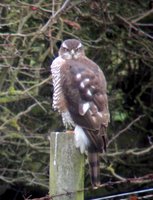
There were plenty of other treats this morning - it was a beautiful crisp day, and most of the usual Leam Valley residents were out. These included two Green Woodpeckers, a Jay, a Kingfisher along the first section of the River Leam, two Sky Lark over Offchurch Bury fields and a Buzzard which sat motionless for 15 minutes or more opposite the hide.
I also found my first Fieldfares of the year, a flock of 40 or so along the river at Offchurch Bury Weir. Every year I forget how striking these large winter thrushes are, so every year they are a wonderful surprise.
 The upshot of this lifestyle is that the Sparrowhawk is rarely seen, and so generally under recorded. Which makes today's walk around Leam Valley all the more unusual, with five (yes, count them, five) separate Sparrowhawk sightings.
The upshot of this lifestyle is that the Sparrowhawk is rarely seen, and so generally under recorded. Which makes today's walk around Leam Valley all the more unusual, with five (yes, count them, five) separate Sparrowhawk sightings.First one flew high over me, following the line of the River Leam. Then, as I settled down in the hide for 30 minutes or so, I witnessed an attempted attack on three Redwings (unsuccessful) followed by a slow pass over the water, probably by the same bird. Later that morning, as I walked towards Offchurch Bury weir, I witnessed two separate Sparrowhawks being mobbed by other birds (first Jackdaw, then a finch species).
Five sightings is unusual, but the fact that most of them were pretty fleeting is not! None lasted longer than 10 seconds, so these photographs are from earlier encounters - the male on the left at Brandon Marsh, the female on the right at Slimbridge.

There were plenty of other treats this morning - it was a beautiful crisp day, and most of the usual Leam Valley residents were out. These included two Green Woodpeckers, a Jay, a Kingfisher along the first section of the River Leam, two Sky Lark over Offchurch Bury fields and a Buzzard which sat motionless for 15 minutes or more opposite the hide.
I also found my first Fieldfares of the year, a flock of 40 or so along the river at Offchurch Bury Weir. Every year I forget how striking these large winter thrushes are, so every year they are a wonderful surprise.
1 November 2006
Starlings and speed birding in Wales
A business trip to North Wales gave me the opportunity to pop in at Conwy RSPB reserve this week.
It was getting late by the time I arrived, so I set off around the reserve at some pace. The main interest was the estuary, with hundreds of Wigeon, some Redshank and Lapwing dotted about, and a Red-breasted Merganser, not a bird I see too often.
But the real highlight was the Starling roost - thousands, perhaps tens of thousands of birds pouring into the reedbeds in ever larger groups, turning in the evening light and creating beautiful shapes in the sky. A nice way to wrap up a day's work.
It was getting late by the time I arrived, so I set off around the reserve at some pace. The main interest was the estuary, with hundreds of Wigeon, some Redshank and Lapwing dotted about, and a Red-breasted Merganser, not a bird I see too often.
But the real highlight was the Starling roost - thousands, perhaps tens of thousands of birds pouring into the reedbeds in ever larger groups, turning in the evening light and creating beautiful shapes in the sky. A nice way to wrap up a day's work.
29 October 2006
Barn Owls at Napton
One of the predictions from my 'wish list' post came true today (see here), with the discovery of two Barn Owls on the edge of my patch. Actually 'discovery' is stretching the truth a bit - I had a tip off. But a Barn Owl is a Barn Owl, and I'm thrilled.
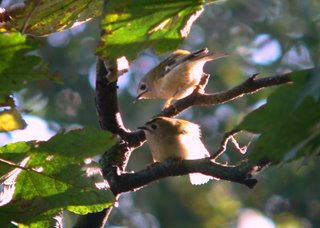 It's been a beautiful day, and I had a lovely morning at Napton. The female Goosander is still there, along with many of the usual residents - a large number of Coots (c. 85), a few Tufted Ducks and plenty of Black-headed Gulls. Other birds of note included a couple of Grey Wagtail, a Cettis Warbler (heard only), a plentiful supply of thrushes included Redwing and a Song Thrush, and a field seemingly full of Sky Larks - perhaps only 6 or 8 though.
It's been a beautiful day, and I had a lovely morning at Napton. The female Goosander is still there, along with many of the usual residents - a large number of Coots (c. 85), a few Tufted Ducks and plenty of Black-headed Gulls. Other birds of note included a couple of Grey Wagtail, a Cettis Warbler (heard only), a plentiful supply of thrushes included Redwing and a Song Thrush, and a field seemingly full of Sky Larks - perhaps only 6 or 8 though.
 I drove next to Brandon (past a field containing perhaps 120+ Lapwing) and was pleased to find a few nice birds, albeit again nothing exceptional - plenty of Lapwing, more than 20 Common Snipe, a female Pintail and plenty of Goldcrest, including a rare opportunity to photograph a pair.
I drove next to Brandon (past a field containing perhaps 120+ Lapwing) and was pleased to find a few nice birds, albeit again nothing exceptional - plenty of Lapwing, more than 20 Common Snipe, a female Pintail and plenty of Goldcrest, including a rare opportunity to photograph a pair.
In East Marsh Hide I met two old acquaintenance, and it was one of these gents who tipped me off about the Napton Barn Owls. So back I went at 4.30pm this evening and... bingo! There they were. Beautiful pale birds, ghostlike and silent across the fields in the gathering gloom - deadly predators and yet surprisingly easy for Magpies and crows to mob and bully away, something which happened a couple of times.

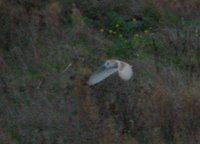
These were birds I'd wanted on the patch for years, so I stood, watched and photographed until the light had all but gone. Brilliant.
 It's been a beautiful day, and I had a lovely morning at Napton. The female Goosander is still there, along with many of the usual residents - a large number of Coots (c. 85), a few Tufted Ducks and plenty of Black-headed Gulls. Other birds of note included a couple of Grey Wagtail, a Cettis Warbler (heard only), a plentiful supply of thrushes included Redwing and a Song Thrush, and a field seemingly full of Sky Larks - perhaps only 6 or 8 though.
It's been a beautiful day, and I had a lovely morning at Napton. The female Goosander is still there, along with many of the usual residents - a large number of Coots (c. 85), a few Tufted Ducks and plenty of Black-headed Gulls. Other birds of note included a couple of Grey Wagtail, a Cettis Warbler (heard only), a plentiful supply of thrushes included Redwing and a Song Thrush, and a field seemingly full of Sky Larks - perhaps only 6 or 8 though. I drove next to Brandon (past a field containing perhaps 120+ Lapwing) and was pleased to find a few nice birds, albeit again nothing exceptional - plenty of Lapwing, more than 20 Common Snipe, a female Pintail and plenty of Goldcrest, including a rare opportunity to photograph a pair.
I drove next to Brandon (past a field containing perhaps 120+ Lapwing) and was pleased to find a few nice birds, albeit again nothing exceptional - plenty of Lapwing, more than 20 Common Snipe, a female Pintail and plenty of Goldcrest, including a rare opportunity to photograph a pair.In East Marsh Hide I met two old acquaintenance, and it was one of these gents who tipped me off about the Napton Barn Owls. So back I went at 4.30pm this evening and... bingo! There they were. Beautiful pale birds, ghostlike and silent across the fields in the gathering gloom - deadly predators and yet surprisingly easy for Magpies and crows to mob and bully away, something which happened a couple of times.


These were birds I'd wanted on the patch for years, so I stood, watched and photographed until the light had all but gone. Brilliant.
23 October 2006
Uncommon Mistle Thrushes
I saw a Mistle Thrush today, high in a tree by a churchyard as I took a lunchtime stroll in Henley-in-Arden. I did not see it well - I had no binoculars with me, and the bird was very high up - but the dry churring call was unmistakeable.
I knew it was some time since I had seen one, but I was amazed to go back through my records and find that this was my first since October 2005. Even more amazingly, the vast majority of my sightings have been while on holiday. Warwickshire sightings have been confined to fairly regular winter encounters in Henley-in-Arden, a June sighting in Long Itchington, and a solitary October sighting at Leam Valley.
Technically this is a fairly common bird, but clearly not so on my patch. They do have notably large breeding territories, so one never finds them in large densities, but I would have expected a few more local sightings over the last three years. Offchurch Bury Estate in particular should suit the species since it favours open parkland and woodland with mature fields. I shall keep my eyes open with renewed vigour for this large and powerful thrush.
I knew it was some time since I had seen one, but I was amazed to go back through my records and find that this was my first since October 2005. Even more amazingly, the vast majority of my sightings have been while on holiday. Warwickshire sightings have been confined to fairly regular winter encounters in Henley-in-Arden, a June sighting in Long Itchington, and a solitary October sighting at Leam Valley.
Technically this is a fairly common bird, but clearly not so on my patch. They do have notably large breeding territories, so one never finds them in large densities, but I would have expected a few more local sightings over the last three years. Offchurch Bury Estate in particular should suit the species since it favours open parkland and woodland with mature fields. I shall keep my eyes open with renewed vigour for this large and powerful thrush.
22 October 2006
On the Essex salt marshes
A wonderful Saturday spent on and near the Essex coast.
First to Abberton Reservoir, a huge body of water not far from the coast which attracts huge numbers of wintering birds. This trip saw plenty of Coot, Tufted Duck, Pochard and various gulls out on the water, as well as some Black-tailed Godwits and a couple of female Pintails. On the nearby Peninsula Trail however I found my star birds - a small flock of 17 Red-legged Partridges. Not a rare bird, but one I don't see on my patch, so these great views were a real pleasure.
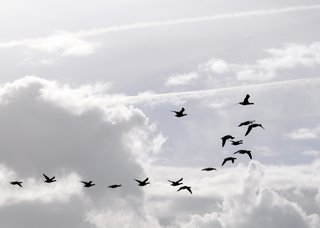 Then off to the nearby Blackwater Estuary where I walked across the RSPB Old Hall Marsh reserve. This is a beautiful but desolate spot, acres of saltmarsh with traditional farmland nearby. It is also a birding paradise. Hundreds of dark-bellied Brent Geese were sweeping in off the coast, along with thousands of Wigeon. Overhead flew flocks of Golden Plover and Lapwing, with the occasional Curlew or Little Egret. I also found got great views of a Sparrowhawk, a Kingfisher and a pair of Stonechat.
Then off to the nearby Blackwater Estuary where I walked across the RSPB Old Hall Marsh reserve. This is a beautiful but desolate spot, acres of saltmarsh with traditional farmland nearby. It is also a birding paradise. Hundreds of dark-bellied Brent Geese were sweeping in off the coast, along with thousands of Wigeon. Overhead flew flocks of Golden Plover and Lapwing, with the occasional Curlew or Little Egret. I also found got great views of a Sparrowhawk, a Kingfisher and a pair of Stonechat.
55 species in all, which is no mean return for a morning's birdwatching - and I was able to add half a dozen more the following morning at Hatfield Forest. Thank you Essex.
First to Abberton Reservoir, a huge body of water not far from the coast which attracts huge numbers of wintering birds. This trip saw plenty of Coot, Tufted Duck, Pochard and various gulls out on the water, as well as some Black-tailed Godwits and a couple of female Pintails. On the nearby Peninsula Trail however I found my star birds - a small flock of 17 Red-legged Partridges. Not a rare bird, but one I don't see on my patch, so these great views were a real pleasure.
 Then off to the nearby Blackwater Estuary where I walked across the RSPB Old Hall Marsh reserve. This is a beautiful but desolate spot, acres of saltmarsh with traditional farmland nearby. It is also a birding paradise. Hundreds of dark-bellied Brent Geese were sweeping in off the coast, along with thousands of Wigeon. Overhead flew flocks of Golden Plover and Lapwing, with the occasional Curlew or Little Egret. I also found got great views of a Sparrowhawk, a Kingfisher and a pair of Stonechat.
Then off to the nearby Blackwater Estuary where I walked across the RSPB Old Hall Marsh reserve. This is a beautiful but desolate spot, acres of saltmarsh with traditional farmland nearby. It is also a birding paradise. Hundreds of dark-bellied Brent Geese were sweeping in off the coast, along with thousands of Wigeon. Overhead flew flocks of Golden Plover and Lapwing, with the occasional Curlew or Little Egret. I also found got great views of a Sparrowhawk, a Kingfisher and a pair of Stonechat.55 species in all, which is no mean return for a morning's birdwatching - and I was able to add half a dozen more the following morning at Hatfield Forest. Thank you Essex.
21 October 2006
Leave Essex alone!
Let's face it - Essex gets a rough old time.
I'm not exempt from blame in this respect, since I like an Essex girl joke as much as the next man. Particularly since J is from Harlow and I can't resist a cheap shot. I've no doubt I'm the poorer man for that.
However, since J still has family towards the north of Essex, I am a reasonably regular visitor, and I'm starting to reach the conclusion that we've all been more than a little harsh.
For a start, I'll admit it's got some towns I'm not mad keen on. But then where hasn't - I'm from Watford in the neighbouring county of Hertfordshire, and that's not going to win any beauty parades (just don't diss the football team - I'm not called Hornet for nothing). Even my beloved Warwickshire has its fair share of less desirable locations (no names, no pack drill) - but that's no reason to dislike a whole county.
What Essex has going for it is sheer scale and diversity. It's huge. As well as Harlow, Basildon, Canvey Island, Stansted Airport, the M11 and M25, it also has Hatfield Forest (authentic medieval woodland), wide open agricultural spaces, miles and miles of coastline, and fantastic saltmarshes and tidal estuary.
And, being a birder, it is the latter which really excite me! Thanks to a recommendation from Pete I've just come back from the Blackwater Estuary (Old Hall Marshes et al) where I had the most beautiful afternoon imaginable (report to follow).
On the basis of that visit, plus my Sunday morning stroll around Hatfield Forest, plus all the other adventures that can be had in this most maligned of counties, I urge you to give Essex a second chance - it'll be worth it I promise.
I'm not exempt from blame in this respect, since I like an Essex girl joke as much as the next man. Particularly since J is from Harlow and I can't resist a cheap shot. I've no doubt I'm the poorer man for that.
However, since J still has family towards the north of Essex, I am a reasonably regular visitor, and I'm starting to reach the conclusion that we've all been more than a little harsh.
For a start, I'll admit it's got some towns I'm not mad keen on. But then where hasn't - I'm from Watford in the neighbouring county of Hertfordshire, and that's not going to win any beauty parades (just don't diss the football team - I'm not called Hornet for nothing). Even my beloved Warwickshire has its fair share of less desirable locations (no names, no pack drill) - but that's no reason to dislike a whole county.
What Essex has going for it is sheer scale and diversity. It's huge. As well as Harlow, Basildon, Canvey Island, Stansted Airport, the M11 and M25, it also has Hatfield Forest (authentic medieval woodland), wide open agricultural spaces, miles and miles of coastline, and fantastic saltmarshes and tidal estuary.
And, being a birder, it is the latter which really excite me! Thanks to a recommendation from Pete I've just come back from the Blackwater Estuary (Old Hall Marshes et al) where I had the most beautiful afternoon imaginable (report to follow).
On the basis of that visit, plus my Sunday morning stroll around Hatfield Forest, plus all the other adventures that can be had in this most maligned of counties, I urge you to give Essex a second chance - it'll be worth it I promise.
17 October 2006
The gathering gloom
The drive home from work is when I most notice the onset of darker nights.
This year's warm weather has held at bay most thoughts of autumn , but last night it felt decidely autumnal as I headed home, headlights already on.
However, one of the beauties of birding is that it can be done anywhere, and pretty much at any time. Even as I drove through the gathering gloom, birds were everywhere.
As I approached the A46, half a dozen partridges flew low over the road in front of me - surely Red-legged since I've never seen any Grey Partridges anywhere near here (or anywhere else come to that). As I headed on towards the Fosse Way a huge flock of Rooks erupted into flight from Ashorne Wood. And as I got out of my car, a Robin and two Blackbirds seemed to be engaged in a shouting match near my drive.
It's these little moments and encounters that make birding a constant pleasure, not just an occasional hobby. Whether it is a Kingfisher flashing along the local stream on my lunchtime stroll, or a Green Woodpecker calling noisily in fields near my garden, there is never a day when I don't partake in, and enjoy, some sort of birdwatching.
This year's warm weather has held at bay most thoughts of autumn , but last night it felt decidely autumnal as I headed home, headlights already on.
However, one of the beauties of birding is that it can be done anywhere, and pretty much at any time. Even as I drove through the gathering gloom, birds were everywhere.
As I approached the A46, half a dozen partridges flew low over the road in front of me - surely Red-legged since I've never seen any Grey Partridges anywhere near here (or anywhere else come to that). As I headed on towards the Fosse Way a huge flock of Rooks erupted into flight from Ashorne Wood. And as I got out of my car, a Robin and two Blackbirds seemed to be engaged in a shouting match near my drive.
It's these little moments and encounters that make birding a constant pleasure, not just an occasional hobby. Whether it is a Kingfisher flashing along the local stream on my lunchtime stroll, or a Green Woodpecker calling noisily in fields near my garden, there is never a day when I don't partake in, and enjoy, some sort of birdwatching.
14 October 2006
When a plan comes together
Yesterday I wrote:
 Unfortunately Leam Valley did little to lift my spirits. The mist lingered throughout my visit, and there were no spectacular finds to be had. There were certainly an unusually high number of Long-tailed Tits though, a theme that was to continue at Ufton and Napton, and also a goodly number of Goldfinch, along with a couple of old favourites, a male Bullfinch and a Grey Wagtail.
Unfortunately Leam Valley did little to lift my spirits. The mist lingered throughout my visit, and there were no spectacular finds to be had. There were certainly an unusually high number of Long-tailed Tits though, a theme that was to continue at Ufton and Napton, and also a goodly number of Goldfinch, along with a couple of old favourites, a male Bullfinch and a Grey Wagtail.
I pressed on to Ufton, but found little to lighten the mood on this grey morning. The only new birds for the day were a Jay, a few Goldcrest and a Coal Tit. So far I had been out for three hours, found just 25 species, and precious little sign of autumn.
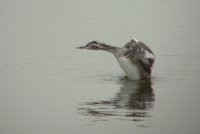
It was Napton which restored my spirits and refreshed my soul. After an unpromising walk round the north water (the smaller of the two areas of open water), I turned back to view the south water and there before me was a female Goosander. I swear it was at that very moment that the mist lifted and the sun came out. Goosanders are wonderful ducks, sleek and bright and a real winter pleasure. They breed near fast-flowing rivers in the north, and then head south to spend the winter somewhere a little warmer. They are common at nearby Draycote Reservoir, but on my patch I've only previously found them on one occasion at Leam Valley.
the winter somewhere a little warmer. They are common at nearby Draycote Reservoir, but on my patch I've only previously found them on one occasion at Leam Valley.
The Goosander on its own was sufficient to make a good morning, but it got better still. I quickly located a female Wigeon, again only my second on patch, and the first for two years. A big flock of Starlings was great to watch, but even more so when a late-migrating Hobby flew through the middle of the flock, heading resolutely south.
There were other good birds - eight Skylarks caused a commotion nearby, four Reed Buntings showed well, and three Bullfinch played in the ever-strengthening sun. The photos above are of some of the more obliging birds - a Black-headed Gull, a singing Robin (perhaps freshly arrived from Germany, who knows?), and a juvenile Great Crested Grebe, still quite young in its stripey plumage.
But for me, the highlight of the whole day was the sight and sound of nine Redwing flying overhead. These quintessential autumn migrants are newly arrived, perhaps from Scandinavia or even further north. They are neat and handsome thrushs with red underwings and a distinctive pale stripe over the eye. They can be seen throughout the winter, either feeding on berries or flying overhead, sometimes in huge flocks. Look out for them and enjoy them while you can - they were a thrill for me today, and will continue to be through the long winter months ahead.
"OK, so the wind is E / SE. Perfect. Tomorrow (Saturday) morning is clear, I have permission from J to go birding (!), and I have the car. The weather forecast is good. Surely nothing can stop me now?"Except, I realised as I opened the curtains at 6.30am this morning, a thick mist and awful visibility - which is a shame, because that's exactly what I got. Still, we patch birders are a hardy breed, so with hope in my heart I headed off on my marathon morning, planning to visit Leam Valley, Ufton Fields and then Napton Reservoir if time allowed.
 Unfortunately Leam Valley did little to lift my spirits. The mist lingered throughout my visit, and there were no spectacular finds to be had. There were certainly an unusually high number of Long-tailed Tits though, a theme that was to continue at Ufton and Napton, and also a goodly number of Goldfinch, along with a couple of old favourites, a male Bullfinch and a Grey Wagtail.
Unfortunately Leam Valley did little to lift my spirits. The mist lingered throughout my visit, and there were no spectacular finds to be had. There were certainly an unusually high number of Long-tailed Tits though, a theme that was to continue at Ufton and Napton, and also a goodly number of Goldfinch, along with a couple of old favourites, a male Bullfinch and a Grey Wagtail.I pressed on to Ufton, but found little to lighten the mood on this grey morning. The only new birds for the day were a Jay, a few Goldcrest and a Coal Tit. So far I had been out for three hours, found just 25 species, and precious little sign of autumn.

It was Napton which restored my spirits and refreshed my soul. After an unpromising walk round the north water (the smaller of the two areas of open water), I turned back to view the south water and there before me was a female Goosander. I swear it was at that very moment that the mist lifted and the sun came out. Goosanders are wonderful ducks, sleek and bright and a real winter pleasure. They breed near fast-flowing rivers in the north, and then head south to spend
 the winter somewhere a little warmer. They are common at nearby Draycote Reservoir, but on my patch I've only previously found them on one occasion at Leam Valley.
the winter somewhere a little warmer. They are common at nearby Draycote Reservoir, but on my patch I've only previously found them on one occasion at Leam Valley.The Goosander on its own was sufficient to make a good morning, but it got better still. I quickly located a female Wigeon, again only my second on patch, and the first for two years. A big flock of Starlings was great to watch, but even more so when a late-migrating Hobby flew through the middle of the flock, heading resolutely south.
There were other good birds - eight Skylarks caused a commotion nearby, four Reed Buntings showed well, and three Bullfinch played in the ever-strengthening sun. The photos above are of some of the more obliging birds - a Black-headed Gull, a singing Robin (perhaps freshly arrived from Germany, who knows?), and a juvenile Great Crested Grebe, still quite young in its stripey plumage.
But for me, the highlight of the whole day was the sight and sound of nine Redwing flying overhead. These quintessential autumn migrants are newly arrived, perhaps from Scandinavia or even further north. They are neat and handsome thrushs with red underwings and a distinctive pale stripe over the eye. They can be seen throughout the winter, either feeding on berries or flying overhead, sometimes in huge flocks. Look out for them and enjoy them while you can - they were a thrill for me today, and will continue to be through the long winter months ahead.
13 October 2006
On your marks...
OK, so the wind is E / SE. Perfect. Tomorrow (Saturday) morning is clear, I have permission from J to go birding (!), and I have the car. The weather forecast is good. Surely nothing can stop me now?
In case this doesn't make a lot of sense to you, mid October is a prime time for birdwatching, because it is migration time. Hundreds of thousands, if not millions of birds are pouring down into the UK from Europe and the Arctic Circle, some rare, some not, and all either passing through on their way south or settling down here for the winter. An E / SE wind will help push them west towards Warwickshire, and I'm gonna find them.
Wish me luck.
In case this doesn't make a lot of sense to you, mid October is a prime time for birdwatching, because it is migration time. Hundreds of thousands, if not millions of birds are pouring down into the UK from Europe and the Arctic Circle, some rare, some not, and all either passing through on their way south or settling down here for the winter. An E / SE wind will help push them west towards Warwickshire, and I'm gonna find them.
Wish me luck.
8 October 2006
The real Autumn Watch
Back to where it all began - Minsmere, the bird reserve in Suffolk where I did my first 'proper' birdwatching.
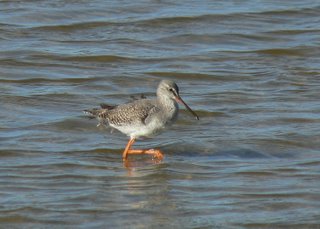 J and I have just returned from a lovely two-day break with plenty of good birding. Perfect weather, a nice pub in which to hunker down on Saturday night, and some good birds - 63 species in all including (and here I select a few favourites at random) Spotted Redshanks (right), Barnacle Geese, Stonechats (below left), Bearded Tits, Marsh Harriers (below right), a couple of Ruff and a nice selection of woodland birds (Marsh and Willow Tits, Goldcrest, Treecreepers, Green and Great Spotted
J and I have just returned from a lovely two-day break with plenty of good birding. Perfect weather, a nice pub in which to hunker down on Saturday night, and some good birds - 63 species in all including (and here I select a few favourites at random) Spotted Redshanks (right), Barnacle Geese, Stonechats (below left), Bearded Tits, Marsh Harriers (below right), a couple of Ruff and a nice selection of woodland birds (Marsh and Willow Tits, Goldcrest, Treecreepers, Green and Great Spotted  Woodpeckers, and two separate Sparrowhawk encounters).
Woodpeckers, and two separate Sparrowhawk encounters).
But a real high point was following the advice of Bill Oddie, Kate Humble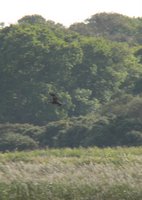 and particularly Simon King on BBC's Autumn Watch and getting out to see the rutting Red Deer. First thing on Sunday morning we set off into the woods, following the (somewhat scary) bellows of the rutting stags and trying to catch a glimpse. Eventually after much creeping and waiting we were rewarded with a glimpse, albeit brief, of three deer - a stag, a doe and a youngster.
and particularly Simon King on BBC's Autumn Watch and getting out to see the rutting Red Deer. First thing on Sunday morning we set off into the woods, following the (somewhat scary) bellows of the rutting stags and trying to catch a glimpse. Eventually after much creeping and waiting we were rewarded with a glimpse, albeit brief, of three deer - a stag, a doe and a youngster.
Ironically it was as we returned to our car, chatting away without a care in the world, that a fine stag walked out virtually in front of us, giving us the best views of the morning. Proving yet again that there's nothing more unpredictable than wildlife.
 J and I have just returned from a lovely two-day break with plenty of good birding. Perfect weather, a nice pub in which to hunker down on Saturday night, and some good birds - 63 species in all including (and here I select a few favourites at random) Spotted Redshanks (right), Barnacle Geese, Stonechats (below left), Bearded Tits, Marsh Harriers (below right), a couple of Ruff and a nice selection of woodland birds (Marsh and Willow Tits, Goldcrest, Treecreepers, Green and Great Spotted
J and I have just returned from a lovely two-day break with plenty of good birding. Perfect weather, a nice pub in which to hunker down on Saturday night, and some good birds - 63 species in all including (and here I select a few favourites at random) Spotted Redshanks (right), Barnacle Geese, Stonechats (below left), Bearded Tits, Marsh Harriers (below right), a couple of Ruff and a nice selection of woodland birds (Marsh and Willow Tits, Goldcrest, Treecreepers, Green and Great Spotted  Woodpeckers, and two separate Sparrowhawk encounters).
Woodpeckers, and two separate Sparrowhawk encounters).But a real high point was following the advice of Bill Oddie, Kate Humble
 and particularly Simon King on BBC's Autumn Watch and getting out to see the rutting Red Deer. First thing on Sunday morning we set off into the woods, following the (somewhat scary) bellows of the rutting stags and trying to catch a glimpse. Eventually after much creeping and waiting we were rewarded with a glimpse, albeit brief, of three deer - a stag, a doe and a youngster.
and particularly Simon King on BBC's Autumn Watch and getting out to see the rutting Red Deer. First thing on Sunday morning we set off into the woods, following the (somewhat scary) bellows of the rutting stags and trying to catch a glimpse. Eventually after much creeping and waiting we were rewarded with a glimpse, albeit brief, of three deer - a stag, a doe and a youngster.Ironically it was as we returned to our car, chatting away without a care in the world, that a fine stag walked out virtually in front of us, giving us the best views of the morning. Proving yet again that there's nothing more unpredictable than wildlife.
3 October 2006
Local migration
The first thing I noticed on my walk around the Radford Semele fields today was the effect of heavy rain - the soil was slick on the hills where the water had poured off, the roads at the bottom were covered in soil and stones, and the horse paddock had a ferocious stream running through it where previously there had been a path. Our weather certainly seems to be more extreme at the moment - a mini-drought followed by ferocious rains, combined with consistently high temperatures (this September being the warmest since records began).
The second thing I noticed was the effects of autumn migration and the onset of winter - hedgerows full of warblers, fields full of feeding finch flocks (pardon the accidental alliteration), and birds calling all over the place.
Nothing special turned up, but there was plenty to keep me interested. Of note were good views of a Blackcap and Garden Warbler (plus half a dozen calling Chiffchaffs), 40 or more Swallows at the top of Pounce Hill with good numbers of of House Martin (ready for their journeys to Africa in the coming days), a female Reed Bunting and several Skylarks singing high above.
The second thing I noticed was the effects of autumn migration and the onset of winter - hedgerows full of warblers, fields full of feeding finch flocks (pardon the accidental alliteration), and birds calling all over the place.
Nothing special turned up, but there was plenty to keep me interested. Of note were good views of a Blackcap and Garden Warbler (plus half a dozen calling Chiffchaffs), 40 or more Swallows at the top of Pounce Hill with good numbers of of House Martin (ready for their journeys to Africa in the coming days), a female Reed Bunting and several Skylarks singing high above.
2 October 2006
Back to Warwickshire
 I came back from holiday to discover an Osprey had been frequenting Brandon Marsh. These are lovely birds which I've only previously seen at Rutland Reservoir (they have an amazing reintroduction programme - see details here).
I came back from holiday to discover an Osprey had been frequenting Brandon Marsh. These are lovely birds which I've only previously seen at Rutland Reservoir (they have an amazing reintroduction programme - see details here).Of course I headed to Brandon as soon as I was able, but sadly it was not to be - I was there in the morning, and the Osprey decided to give it a miss until the afternoon. Blast. Still, it was nice to be back on local ground with a distinct autumn / winter feel to the birding.
An obliging Kingisher sat just in front of me for 10 minutes or more, and elsewhere there were 300 or more Lapwing, Teal and Shovellers, Green and Great Spotted Woodpecker, and a Green Sandpiper at Carlton hide.
1 October 2006
A big day in Cornwall
What a fantastic break - a week with all my family in a cottage not far from Padstow in Cornwall. So what did that mean in practice?
(i) A gym, a swimming pool, a superb restaurant, luxury accomodation and general pampering;
(ii) My parents on hand for some very welcome babysitting - J and I had our first meal out together for ages and I got a full day birdwatching (of which more in a moment);
(iii) Cornwall in late September - with migration now fully underway, surely even I can something interesting.
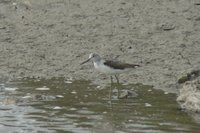

So when the opportunity for a day out birding arose, I grabbed it with both hands. Up at 6am, dropped my brother off for his day's fishing at 6.30am, and was on the Camel Estuary by 7am.
The tide was out, but I was able to find a few waders, a Greenshank being the best. Just a short walk away were some river marshes - here I found two Little Egrets preening just a few metres from me, four or five Snipe and a Hobby squatting powerfully on a mudbank for 10 minutes or more.
 I headed to the coast, and from clifftops I saw Gannets passing south, and Oystercatchers and Cormorants on the rocky shore. For the first time ever I saw a family of Dolphins arcing in and out of the water right below my feet.
I headed to the coast, and from clifftops I saw Gannets passing south, and Oystercatchers and Cormorants on the rocky shore. For the first time ever I saw a family of Dolphins arcing in and out of the water right below my feet.
It was a good day's birding, with 45 or so species chalked up, albeit nothing rare. The next day J and I walked up the other side of the Camel Estuary, adding Dunlin, Ringed Plover and Bar-tailed Godwit to my trip list. With a few local woodland birds near the cottage, the list headed up towards 50 - not exactly a record, but a reflection of some good varied birding in the limited amount of free time family life currently allows.
(i) A gym, a swimming pool, a superb restaurant, luxury accomodation and general pampering;
(ii) My parents on hand for some very welcome babysitting - J and I had our first meal out together for ages and I got a full day birdwatching (of which more in a moment);
(iii) Cornwall in late September - with migration now fully underway, surely even I can something interesting.


So when the opportunity for a day out birding arose, I grabbed it with both hands. Up at 6am, dropped my brother off for his day's fishing at 6.30am, and was on the Camel Estuary by 7am.
The tide was out, but I was able to find a few waders, a Greenshank being the best. Just a short walk away were some river marshes - here I found two Little Egrets preening just a few metres from me, four or five Snipe and a Hobby squatting powerfully on a mudbank for 10 minutes or more.
 I headed to the coast, and from clifftops I saw Gannets passing south, and Oystercatchers and Cormorants on the rocky shore. For the first time ever I saw a family of Dolphins arcing in and out of the water right below my feet.
I headed to the coast, and from clifftops I saw Gannets passing south, and Oystercatchers and Cormorants on the rocky shore. For the first time ever I saw a family of Dolphins arcing in and out of the water right below my feet.It was a good day's birding, with 45 or so species chalked up, albeit nothing rare. The next day J and I walked up the other side of the Camel Estuary, adding Dunlin, Ringed Plover and Bar-tailed Godwit to my trip list. With a few local woodland birds near the cottage, the list headed up towards 50 - not exactly a record, but a reflection of some good varied birding in the limited amount of free time family life currently allows.
Not much birding in Yorkshire
So why did it take me three weeks to fix The Hornet's Nest anyway? Well, to be fair I was on holiday for most of the time, a week in Yorkshire followed by a week in Cornwall.
We visited a lovely part of Yorkshire, a village called Harden not far from Ilkley, Howarth and the moors. We have been here before, and there are some nice birding strolls - moors of course, plus the St Ives Estate with a particularly fine park and woodlands to enjoy.
 Sadly, on this occasion there was little (ie no) time for 'real' birding. Instead we enjoyed a few family outings - to Ilkley (quiet, but a really nice place), Bolton Abbey (a beautiful spot), and the national photography, television and film museum in Bradford (go, I urge you - I love the place).
Sadly, on this occasion there was little (ie no) time for 'real' birding. Instead we enjoyed a few family outings - to Ilkley (quiet, but a really nice place), Bolton Abbey (a beautiful spot), and the national photography, television and film museum in Bradford (go, I urge you - I love the place).
However, a birder is never off-duty, so on on our few family outings I managed to find a few decebt birds - a Dipper on the local stream, Nuthatch at Bolton Abbey, and on the St Ives Estate, more Nuthatch, a Treecreeper, plenty of Goldcrest and a tree-full of Coal Tits.
Nothing to write home about, so onwards and upwards to the main birding event, Cornwall.
We visited a lovely part of Yorkshire, a village called Harden not far from Ilkley, Howarth and the moors. We have been here before, and there are some nice birding strolls - moors of course, plus the St Ives Estate with a particularly fine park and woodlands to enjoy.
 Sadly, on this occasion there was little (ie no) time for 'real' birding. Instead we enjoyed a few family outings - to Ilkley (quiet, but a really nice place), Bolton Abbey (a beautiful spot), and the national photography, television and film museum in Bradford (go, I urge you - I love the place).
Sadly, on this occasion there was little (ie no) time for 'real' birding. Instead we enjoyed a few family outings - to Ilkley (quiet, but a really nice place), Bolton Abbey (a beautiful spot), and the national photography, television and film museum in Bradford (go, I urge you - I love the place).However, a birder is never off-duty, so on on our few family outings I managed to find a few decebt birds - a Dipper on the local stream, Nuthatch at Bolton Abbey, and on the St Ives Estate, more Nuthatch, a Treecreeper, plenty of Goldcrest and a tree-full of Coal Tits.
Nothing to write home about, so onwards and upwards to the main birding event, Cornwall.
30 September 2006
You might not like me when I'm angry...
Lots of bloggers seem to spend their time in a state of perpetual fury, so although I like to keep The Hornet's Nest focused on nature and the gentler things in life, I thought I'd give it a try.
Grrrr. Grrrrrrrrrr. This is fun, I'm getting really angry now. And why? Because blogger decided to 'lose' all my template modifications and leave me with no links or features on my sidebar. No 'About the Hornet's Nest', no links to 'My favourite Blogs' and no RSS subscription - just the old basic blog. How dull.
So last night I spent three hours rebuilding the thing, not my idea of a good time (although I did get to add an email subscription service for those of you without RSS readers). I hope you've missed The Hornet's Nest, sorry for the three weeks of incomplete service, and welcome back.
I feel better for that.
Grrrr. Grrrrrrrrrr. This is fun, I'm getting really angry now. And why? Because blogger decided to 'lose' all my template modifications and leave me with no links or features on my sidebar. No 'About the Hornet's Nest', no links to 'My favourite Blogs' and no RSS subscription - just the old basic blog. How dull.
So last night I spent three hours rebuilding the thing, not my idea of a good time (although I did get to add an email subscription service for those of you without RSS readers). I hope you've missed The Hornet's Nest, sorry for the three weeks of incomplete service, and welcome back.
I feel better for that.
10 September 2006
Cetti's Warblers at Napton Reservoir
Along with most birders, I've heard many more Cetti's Warblers than I've seen.
This is a classic 'lurking' bird which loves to stay deep in cover - and yet draws attention to itself with the most extraordinary call, half bird-screech, half electronic voice box. It simply has to be heard to be believed.
It is also not very common in Britain, and has only really colonised here in recent years (nearby Brandon Marsh on the outskirts of Coventry happens to be a real stronghold for them).
So I was delighted to hear two at Napton Reservoir this morning, and even more delighted to see them both for perhaps a minute in all. That is a long Cetti's sighting, believe me. They are quite large warblers, a warm rufous-brown in colour, but generally unremarkable in looks. What really gives them away (apart from that call) is their large, rounded tails which they hold erect, giving them the appearance of a large Wren.
 I got extremely excited at the prospect of photographing a Cetti's, but sadly, by the time the camera was out, a Sedge Warbler (I think a juvenile) had taken their place in the reedbed.
I got extremely excited at the prospect of photographing a Cetti's, but sadly, by the time the camera was out, a Sedge Warbler (I think a juvenile) had taken their place in the reedbed.
Other highlights of the morning were the Swallows, House Martins and Sand Martins still gathering at the site ready for their forthcoming migration, the Reed Buntings around the whole site (perhaps a dozen in all), and a pair of Buzzards mewing loudly and low over Ufton Fields on my way home.
This is a classic 'lurking' bird which loves to stay deep in cover - and yet draws attention to itself with the most extraordinary call, half bird-screech, half electronic voice box. It simply has to be heard to be believed.
It is also not very common in Britain, and has only really colonised here in recent years (nearby Brandon Marsh on the outskirts of Coventry happens to be a real stronghold for them).
So I was delighted to hear two at Napton Reservoir this morning, and even more delighted to see them both for perhaps a minute in all. That is a long Cetti's sighting, believe me. They are quite large warblers, a warm rufous-brown in colour, but generally unremarkable in looks. What really gives them away (apart from that call) is their large, rounded tails which they hold erect, giving them the appearance of a large Wren.
 I got extremely excited at the prospect of photographing a Cetti's, but sadly, by the time the camera was out, a Sedge Warbler (I think a juvenile) had taken their place in the reedbed.
I got extremely excited at the prospect of photographing a Cetti's, but sadly, by the time the camera was out, a Sedge Warbler (I think a juvenile) had taken their place in the reedbed.Other highlights of the morning were the Swallows, House Martins and Sand Martins still gathering at the site ready for their forthcoming migration, the Reed Buntings around the whole site (perhaps a dozen in all), and a pair of Buzzards mewing loudly and low over Ufton Fields on my way home.
9 September 2006
My secret wish list
I imagine that many patch birders have their secret wish lists - the rare birds which they think might, just might, turn up on various parts of their patch.
Patch birding can be quiet, particularly when compared to dashing off to the big birding hotspots, or chasing down twitchable rarities. So, as one wanders around a birdless patch of land on a particularly unpromising day, one tends to finds oneself thinking: "Those conifers would be perfect for a Crossbill or two - it's bound to happen sooner or later!"
So here is my wish list for the various parts of my patch, with my own guess at how likely they are to appear in the next three years:
Leam Valley - spring migrant Wheatears on the hill (50%), Barn Owl over the meadow (75%), Green Sandpiper on the scrape (75%), Firecrest (10%).
Ufton - Turtle Dover (75%), Crossbill (25%), Firecrest (10%), Yellow-browed Warbler (2%).
Cubbington Wood - Goshawk (5%), Lesser Spotted Woodpecker (30%), Woodcock (25%).
Offchurch - Barn Owl on the estate (75%)
Radford Semele - Quail (30%), Red-legged Partridge (50%)
Napton Reservoir - Black-necked Grebe (25%), Wheater (50%), Osprey (1%).
Across whole patch - Raven (50%), Red Kite (75%).
So, not much to ask. All would be patch firsts, and six would be lifers. I'll keep 'em peeled then shall I, and let you know how I get on?
Patch birding can be quiet, particularly when compared to dashing off to the big birding hotspots, or chasing down twitchable rarities. So, as one wanders around a birdless patch of land on a particularly unpromising day, one tends to finds oneself thinking: "Those conifers would be perfect for a Crossbill or two - it's bound to happen sooner or later!"
So here is my wish list for the various parts of my patch, with my own guess at how likely they are to appear in the next three years:
Leam Valley - spring migrant Wheatears on the hill (50%), Barn Owl over the meadow (75%), Green Sandpiper on the scrape (75%), Firecrest (10%).
Ufton - Turtle Dover (75%), Crossbill (25%), Firecrest (10%), Yellow-browed Warbler (2%).
Cubbington Wood - Goshawk (5%), Lesser Spotted Woodpecker (30%), Woodcock (25%).
Offchurch - Barn Owl on the estate (75%)
Radford Semele - Quail (30%), Red-legged Partridge (50%)
Napton Reservoir - Black-necked Grebe (25%), Wheater (50%), Osprey (1%).
Across whole patch - Raven (50%), Red Kite (75%).
So, not much to ask. All would be patch firsts, and six would be lifers. I'll keep 'em peeled then shall I, and let you know how I get on?
3 September 2006
Star birds at Leam Valley and Offchurch
Nearly every birding trip has its star birds, the ones that linger long in the memory.
Sometimes these are 'megas' - rare vagrant birds, unusual migrants or something else a bit out-of-the-ordinary.
On other days, however, they can be more familiar birds - perhaps an old favourite you've not seen for a while, or a particularly good view of something. This morning's walk through Leam Valley, up to Offchurch and back to Radford Semele was one such day.
It was quiet at first, but a few hours of walking, waiting and watching led to some great birding. Two Chiffchaffs offered great views, giving me the chance to study their tail-wagging feeding behaviour. Their plumages were also worthy of note - one dull brown but the second altogether brighter and more yellow.
House Martins filled the sky at one point, perhaps 40 or 50, and that's something I could never tire of. A few more days, perhaps a couple of weeks, and they'll be off to their wintering grounds in East Africa - an amazing thought.
While watching from the hide, a Sparrowhawk flashed by and two Jays showed well. In the hawthorn bushes to the right I got a brief, but welcome, sighting of a male Blackcap, perhaps the most striking of all the warblers.
On leaving the hide, I found a Coal Tit among some Goldcrest and Long-tailed Tit. This was first Coal Tit of the year, and my first ever at Leam Valley. As I walked across the Offchurch Bury Estate, Lesser Black-Backed Gulls headed south above my head, and the sound of Jackdaws filled the air.
My arrival at Offchurch provided the final star bird, a beautiful Nuthatch in St Gregory's churchyard. This is a lovely little spot, deliberately managed for nature (and the place where I memorably found my first ever Spotted Flycatcher a couple of years ago). Across my whole patch I have only previously found Nuthatch at Cubbington Woods, so this was a nice find to wrap the day up.
Three-and-a-half hours, 31 species and some real smashers. Time for a cooked breakfast...
Sometimes these are 'megas' - rare vagrant birds, unusual migrants or something else a bit out-of-the-ordinary.
On other days, however, they can be more familiar birds - perhaps an old favourite you've not seen for a while, or a particularly good view of something. This morning's walk through Leam Valley, up to Offchurch and back to Radford Semele was one such day.
It was quiet at first, but a few hours of walking, waiting and watching led to some great birding. Two Chiffchaffs offered great views, giving me the chance to study their tail-wagging feeding behaviour. Their plumages were also worthy of note - one dull brown but the second altogether brighter and more yellow.
House Martins filled the sky at one point, perhaps 40 or 50, and that's something I could never tire of. A few more days, perhaps a couple of weeks, and they'll be off to their wintering grounds in East Africa - an amazing thought.
While watching from the hide, a Sparrowhawk flashed by and two Jays showed well. In the hawthorn bushes to the right I got a brief, but welcome, sighting of a male Blackcap, perhaps the most striking of all the warblers.
On leaving the hide, I found a Coal Tit among some Goldcrest and Long-tailed Tit. This was first Coal Tit of the year, and my first ever at Leam Valley. As I walked across the Offchurch Bury Estate, Lesser Black-Backed Gulls headed south above my head, and the sound of Jackdaws filled the air.
My arrival at Offchurch provided the final star bird, a beautiful Nuthatch in St Gregory's churchyard. This is a lovely little spot, deliberately managed for nature (and the place where I memorably found my first ever Spotted Flycatcher a couple of years ago). Across my whole patch I have only previously found Nuthatch at Cubbington Woods, so this was a nice find to wrap the day up.
Three-and-a-half hours, 31 species and some real smashers. Time for a cooked breakfast...
28 August 2006
Trial and error at Draycote
Had a lovely family day at Draycote Reservoir today - myself, J, our son Charlie (mainly asleep in the pushchair) and my parents. Either side of a ferocious shower the weather was lovely, bright and breezy, and we walked clockwise from the visitor centre to the valve tower and back.
A family day with good birding? You bet. First of all there were hundreds of House Martins, Sand Martins and Swallows. A Sparrowhawk flew right across the water and a Kestrel patrolled the fields at Draycote Bank.
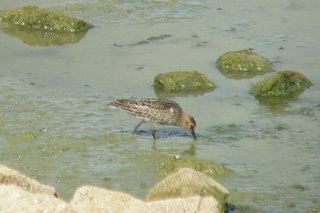
Then at Hensborough Bank we found a small group of waders - two Lapwing, three juvenile Ringed Plover, and two initially unidentified waders. I studied them for some time, thinking first of Dunlin, and then, when I found no evidence of black markings on their bellies, considered Curlew Sandpiper (nope, not elongated enough, and no pale supercilium). Finally, seeing white stripes on the back, I went for Little Stint.
Wrong! A quick posting of some photos on Birdforum allowed several wader experts to help put me right - these were in fact juvenile Dunlin. No shame in making a mistake, only in failing to find out why. I am now settling down with a beer, my Collins fieldguide and a grim determination not to make the same mistake again. Cheers.
(Conclusion - (i) I got carried away with white stripes on the back of the birds, and forgot to stay focused on basic form and size; (ii) Collins is a good fieldguide; (iii) London Pride is an exceptionally good beer).
A family day with good birding? You bet. First of all there were hundreds of House Martins, Sand Martins and Swallows. A Sparrowhawk flew right across the water and a Kestrel patrolled the fields at Draycote Bank.

Then at Hensborough Bank we found a small group of waders - two Lapwing, three juvenile Ringed Plover, and two initially unidentified waders. I studied them for some time, thinking first of Dunlin, and then, when I found no evidence of black markings on their bellies, considered Curlew Sandpiper (nope, not elongated enough, and no pale supercilium). Finally, seeing white stripes on the back, I went for Little Stint.
Wrong! A quick posting of some photos on Birdforum allowed several wader experts to help put me right - these were in fact juvenile Dunlin. No shame in making a mistake, only in failing to find out why. I am now settling down with a beer, my Collins fieldguide and a grim determination not to make the same mistake again. Cheers.
(Conclusion - (i) I got carried away with white stripes on the back of the birds, and forgot to stay focused on basic form and size; (ii) Collins is a good fieldguide; (iii) London Pride is an exceptionally good beer).
27 August 2006
Old friends reunited at Leam Valley
It was a morning for old friends at Leam Valley, finding some of the more elusive residents which I see infrequently enough for each sighting to make a red letter day.
The first were the two Kingfishers which flashed by in front of the hide. One returned moments later to sit on a nearby pole for a quick photo opportunity. Sadly, poor light and little time made for a poor photo, but a nice memory nevertheless.
moments later to sit on a nearby pole for a quick photo opportunity. Sadly, poor light and little time made for a poor photo, but a nice memory nevertheless.
Second was a female Sparrowhawk which dashed across the path in front of me as I left the hide. I got only the briefest of glimpses, but the long brown hooped tail that sped away from me was unmistakeable.
Third was a Blackcap, a brown-headed female in this case, but it is months since I have seen either gender of this lovely little warbler in Warwickshire. And finally, I heard a Garden Warbler - a bird almost impossible to see since it likes to hide deep within the scrub, singing long and loud.
These encounters helped make for a pleasant morning, despite the weather. August has been a much-needed wet month, and although it is not yet officially autumn, this morning felt like it. A little too warm perhaps, but grey and drab, the view across the Leam Valley scrape an unrelenting duotone of muted green and brown (interupted only by the purple loosestrife, an occasional flash of purple-blue speculum from an eclipse-Mallard, or a fly-past by my friends the Kingfishers).
Among the other highlights of the morning were four Great Spotted Woodpeckers (one sitting opposite me for 15 or more minutes), several Green Woodpeckers, a Jay, plenty of Goldcrest, a female Blackcap, Swallows and House Martins, two Buzzards (one mobbed briefly by 60 or more Greenfinches), and a shoal of perhaps 30 chub, some up to 40cms long, sliding elegantly along the river shallows en masse.
The first were the two Kingfishers which flashed by in front of the hide. One returned
 moments later to sit on a nearby pole for a quick photo opportunity. Sadly, poor light and little time made for a poor photo, but a nice memory nevertheless.
moments later to sit on a nearby pole for a quick photo opportunity. Sadly, poor light and little time made for a poor photo, but a nice memory nevertheless.Second was a female Sparrowhawk which dashed across the path in front of me as I left the hide. I got only the briefest of glimpses, but the long brown hooped tail that sped away from me was unmistakeable.
Third was a Blackcap, a brown-headed female in this case, but it is months since I have seen either gender of this lovely little warbler in Warwickshire. And finally, I heard a Garden Warbler - a bird almost impossible to see since it likes to hide deep within the scrub, singing long and loud.
These encounters helped make for a pleasant morning, despite the weather. August has been a much-needed wet month, and although it is not yet officially autumn, this morning felt like it. A little too warm perhaps, but grey and drab, the view across the Leam Valley scrape an unrelenting duotone of muted green and brown (interupted only by the purple loosestrife, an occasional flash of purple-blue speculum from an eclipse-Mallard, or a fly-past by my friends the Kingfishers).
Among the other highlights of the morning were four Great Spotted Woodpeckers (one sitting opposite me for 15 or more minutes), several Green Woodpeckers, a Jay, plenty of Goldcrest, a female Blackcap, Swallows and House Martins, two Buzzards (one mobbed briefly by 60 or more Greenfinches), and a shoal of perhaps 30 chub, some up to 40cms long, sliding elegantly along the river shallows en masse.
Elephant Hawk Moth
This monster turned up on my drive today - the 8cm long larvae of the Elephant Hawk Moth.
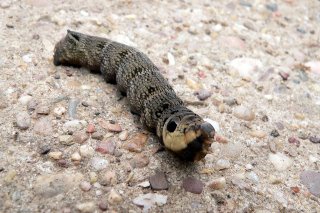
So-called because of the perceived similarity between its head and a (slightly short) elephant trunk, this is a very large caterpillar indeed, with two false eyes designed to frighten off predators. When disturbed it retracts its head into its body, and it can also swell up, enlarging the false eyes. It will also raise its head and move from side to side to deter the predator.

So-called because of the perceived similarity between its head and a (slightly short) elephant trunk, this is a very large caterpillar indeed, with two false eyes designed to frighten off predators. When disturbed it retracts its head into its body, and it can also swell up, enlarging the false eyes. It will also raise its head and move from side to side to deter the predator.

26 August 2006
Mighty Midget 2 ED - A quick review
Birding is a hobby you can enjoy for virtually no cost - £50 will buy you a perfectly reasonable pair of binoculars, £10 a field guide, and perhaps £2 for a notebook.
Unfortunately, there are also many many ways in which you can spend hundreds if not thousands of pounds, and I, like so many birders of my acquaintance, am weak.
So the latest bit of kit is an Opticron Mighty Midget 2 ED travelscope, a small scope designed to fit into a pocket or shoulder bag as I walk around the patch (my main scope, plus tripod, weight about 4kg and so don't tend to get brought out on longish patch walks).
I use an hdf zoom eyepiece on it and together they provide a very impressive optical set up. Bright and distortion-free up to 30x or so, getting darker after that but still perfectly usable up to 36x. A Cullman shoulder pod is almost an essential accessory, making the MM2 an absolute pleasure to use (no more panicking to pull down tripod legs).

I have used the MM2 for some handheld digiscoping - the best so far is this Chaffinch, taken at Draycote Reservoir. With adaptor, shutter release and so on I am sure I could get better pictures, but that is not the point - this is a lightweight take anywhere bit of kit, so handheld is the way to go - record shots and stuff for The Hornet's Nest mainly.
The only problem I have is with cases and lens covers. The eyepiece cover was abysmal - cheap plastic, loose fitting, and I lost it this morning as I knew I soon would. There is also no stay on case available, just a 'grippa' case which doesn't cover the lens hood or eyepiece. My only solution for now is to employ the grippa case with a baby's sock pressed into service as an eyepiece cover.
It might be a great bit of kit, but I don't half look a 'nana now!
Unfortunately, there are also many many ways in which you can spend hundreds if not thousands of pounds, and I, like so many birders of my acquaintance, am weak.
So the latest bit of kit is an Opticron Mighty Midget 2 ED travelscope, a small scope designed to fit into a pocket or shoulder bag as I walk around the patch (my main scope, plus tripod, weight about 4kg and so don't tend to get brought out on longish patch walks).
I use an hdf zoom eyepiece on it and together they provide a very impressive optical set up. Bright and distortion-free up to 30x or so, getting darker after that but still perfectly usable up to 36x. A Cullman shoulder pod is almost an essential accessory, making the MM2 an absolute pleasure to use (no more panicking to pull down tripod legs).

I have used the MM2 for some handheld digiscoping - the best so far is this Chaffinch, taken at Draycote Reservoir. With adaptor, shutter release and so on I am sure I could get better pictures, but that is not the point - this is a lightweight take anywhere bit of kit, so handheld is the way to go - record shots and stuff for The Hornet's Nest mainly.
The only problem I have is with cases and lens covers. The eyepiece cover was abysmal - cheap plastic, loose fitting, and I lost it this morning as I knew I soon would. There is also no stay on case available, just a 'grippa' case which doesn't cover the lens hood or eyepiece. My only solution for now is to employ the grippa case with a baby's sock pressed into service as an eyepiece cover.
It might be a great bit of kit, but I don't half look a 'nana now!

20 August 2006
All purple at Ufton, Napton and Brandon
I took some of my own advice this morning and again broke my normal patch routine.
Having awoken reasonably early (6.20am being, in my book, not a bad effort for a Sunday), I decided to go to Ufton Fields and see if the early-ness of the hour helped me fare better than generally of late.
And lo and behold, it did. I'm not claiming that the place was stuffed to the gills with rare warblers, passage waders and the like, but it was certainly livelier than I had seen it for a while.
Ufton is a difficult place to bird anyway, largely comprising dense woodland and pools with a shortage of obvious viewpoints, as well as a path that follows the circumference of the site, leaving a large interior area in which the birds can remain endlessly hidden.
However, today was pretty good, with 80 or more House Martins twittering high over the site when I arrived, and trees seemingly dripping with young Goldcrest. I was also delighted to find my first ever family party of Bullfinches - two adults and two juveniles, issuing strange wheezing calls which made me think more of grebes than finches.
A Marsh Tit, three Jays and a Kingfisher were among the other high points.
I then moved on to Napton, which apart from demonstrating once more how windy it can be, offered little of note. Time, I figured, for a man of action such as myself to head off in search of... a huge breakfast.
So to Brandon, which, like Ufton Fields earlier this morning, had gone purple - with purple loosestrife in fact. This spiky purple flower is covering anywhere with a bit of moisture at the moment, and splendid it looks to - as this Mallard photos show.
 As for the birds, this was a quick visit after my (excellent) breakfast - two Green Sandpipers on Carlton Pool, along with two Little Grebes, 30 Lapwing on East Marsh Pool, the regular Barnacle Goose (below), a Kingfisher flashing across Goose Pool, and great views of a Great Spotted Woodpecker.
As for the birds, this was a quick visit after my (excellent) breakfast - two Green Sandpipers on Carlton Pool, along with two Little Grebes, 30 Lapwing on East Marsh Pool, the regular Barnacle Goose (below), a Kingfisher flashing across Goose Pool, and great views of a Great Spotted Woodpecker.
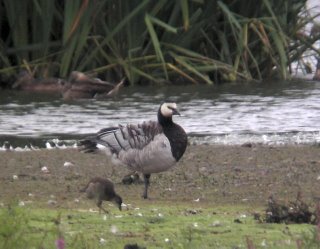 My final sighting of the day was a toad, sitting on the East Marsh track next to a huge dead slug. After last month's frog photos, this was at least a great opportunity to increase my amphibian photographic portfolio.
My final sighting of the day was a toad, sitting on the East Marsh track next to a huge dead slug. After last month's frog photos, this was at least a great opportunity to increase my amphibian photographic portfolio.


 As for the birds, this was a quick visit after my (excellent) breakfast - two Green Sandpipers on Carlton Pool, along with two Little Grebes, 30 Lapwing on East Marsh Pool, the regular Barnacle Goose (below), a Kingfisher flashing across Goose Pool, and great views of a Great Spotted Woodpecker.
As for the birds, this was a quick visit after my (excellent) breakfast - two Green Sandpipers on Carlton Pool, along with two Little Grebes, 30 Lapwing on East Marsh Pool, the regular Barnacle Goose (below), a Kingfisher flashing across Goose Pool, and great views of a Great Spotted Woodpecker.
 My final sighting of the day was a toad, sitting on the East Marsh track next to a huge dead slug. After last month's frog photos, this was at least a great opportunity to increase my amphibian photographic portfolio.
My final sighting of the day was a toad, sitting on the East Marsh track next to a huge dead slug. After last month's frog photos, this was at least a great opportunity to increase my amphibian photographic portfolio.


18 August 2006
Leam Valley - a new perspective
If you are a regular patch birder, may I be so bold as to suggest an idea?
If you've got into a bit of a rut or routine on your patch, as indeed I have, try to do something a little different. Walk a different way round, or follow a different route altogether. Or, as I did tonight, visit a favourite spot at a different time of day. It really does bring a new perpective to somewhere very familiar.
I've got into the habit of seeing Leam Valley as an early morning site. I nearly always try to be there before seven if I can, and hate being late. Perhaps I'm getting old and grumpy, but I love the peace and quiet before the dog walkers arrive. I've also seen some cracking birds there at the crack of dawn.
For evening walks I tend to favour Ufton Fields, which is close to home, has good paths and is easier to walk around. Perhaps this is why I have such a hard time finding good birds at Ufton - I must try a really early start there.
However - back to tonight. Tonight I went for an after work walk around Leam Valley and saw a very different place to the one I thought I knew. The hedges and woods were quieter, with just a few Blue and Great Tits, a few juvenile Chiffchaffs moving noisily through and the occasional song from a Robin or a Wren.
The scrape was alive, more than 70 Mallards or Mallard-hybrids being joined by 30 Canada Geese, a pair of juvenile Moorhens and a Grey Heron. As I made my way back to the car, four Jays flew past one by one, a Green Woodpecker called loudly, and Wood Pigeons, Carrions Crows and Rooks returned to local roosts.
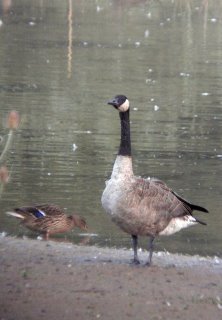
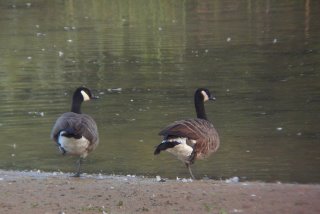

As a final reminder that I was seeing a different side to this favoured part of my patch, a soft mist began to rise off the fields at about 7.30pm, creating an eerie atmosphere in the fading light. A Barn Owl would have suited the occasion marvellously - sadly, it never appeared.
If you've got into a bit of a rut or routine on your patch, as indeed I have, try to do something a little different. Walk a different way round, or follow a different route altogether. Or, as I did tonight, visit a favourite spot at a different time of day. It really does bring a new perpective to somewhere very familiar.
I've got into the habit of seeing Leam Valley as an early morning site. I nearly always try to be there before seven if I can, and hate being late. Perhaps I'm getting old and grumpy, but I love the peace and quiet before the dog walkers arrive. I've also seen some cracking birds there at the crack of dawn.
For evening walks I tend to favour Ufton Fields, which is close to home, has good paths and is easier to walk around. Perhaps this is why I have such a hard time finding good birds at Ufton - I must try a really early start there.
However - back to tonight. Tonight I went for an after work walk around Leam Valley and saw a very different place to the one I thought I knew. The hedges and woods were quieter, with just a few Blue and Great Tits, a few juvenile Chiffchaffs moving noisily through and the occasional song from a Robin or a Wren.
The scrape was alive, more than 70 Mallards or Mallard-hybrids being joined by 30 Canada Geese, a pair of juvenile Moorhens and a Grey Heron. As I made my way back to the car, four Jays flew past one by one, a Green Woodpecker called loudly, and Wood Pigeons, Carrions Crows and Rooks returned to local roosts.



As a final reminder that I was seeing a different side to this favoured part of my patch, a soft mist began to rise off the fields at about 7.30pm, creating an eerie atmosphere in the fading light. A Barn Owl would have suited the occasion marvellously - sadly, it never appeared.
13 August 2006
Napton Reservoir
The weekend has been decidely autumnal, with high winds and constant rain.
I made a quick trip to Napton Reservoir during a break in the rain this afternoon, and was delighted to find the place abuzz with House Martins, Sand Martins and Swallows.
They were all low, some flying past me at waist or even knee height. The Swallows, many of them young, patrolled the grass edges or sat on nearby fences.
The House Martins tended to be over the water, but also flew along the banks at high speed. The Sand Martins, perhaps a dozen on more among the 100+ birds in total, were patrolling the water - but even they came extremely close to me, giving best-ever views of these delicate little birds.
Out on the water, a pair of Great Crested Grebes were notable for the lateness of their nest building - I hope that the weather improves in the coming weeks if they are aiming to raise a late brood.
I made a quick trip to Napton Reservoir during a break in the rain this afternoon, and was delighted to find the place abuzz with House Martins, Sand Martins and Swallows.
They were all low, some flying past me at waist or even knee height. The Swallows, many of them young, patrolled the grass edges or sat on nearby fences.
The House Martins tended to be over the water, but also flew along the banks at high speed. The Sand Martins, perhaps a dozen on more among the 100+ birds in total, were patrolling the water - but even they came extremely close to me, giving best-ever views of these delicate little birds.
Out on the water, a pair of Great Crested Grebes were notable for the lateness of their nest building - I hope that the weather improves in the coming weeks if they are aiming to raise a late brood.
12 August 2006
House and Sand Martins at Brandon
Made an early morning visit to Brandon Marsh today, and found the place swarming with House Martins, particularly over East Marsh Pool, but also down to River Pool.
Closer inspection revealed a few Sand Martins among them, always a nice find because of their general scarcity round here. The conservation team at Brandon built some years ago an artificial sandbank, hoping to attract them to nest, but sadly no joy yet.
Among other highlights were a Little Egret flying overhead, a couple of Green Sandpipers, hedgerows full of juvenile Chiffchaffs and a Reed Warbler which perched right in front of the hide for a minute or so.
Closer inspection revealed a few Sand Martins among them, always a nice find because of their general scarcity round here. The conservation team at Brandon built some years ago an artificial sandbank, hoping to attract them to nest, but sadly no joy yet.
Among other highlights were a Little Egret flying overhead, a couple of Green Sandpipers, hedgerows full of juvenile Chiffchaffs and a Reed Warbler which perched right in front of the hide for a minute or so.
More Yellow Wagtails
I found more Yellow Wagtails tonight, this time at Ufton Fields. So after four years without any Yellow Wags on the patch, two lots have now turned up within five days of each other.
These birds were by the IBM Hide - I heard one and saw a second on top of a hawthorn bush by the path. This enlivened a generally quiet after-work stroll, as did the Green Woodpecker which exploded noisily out of the grass near my feet and scared the bejesus out of me at one point.
These birds were by the IBM Hide - I heard one and saw a second on top of a hawthorn bush by the path. This enlivened a generally quiet after-work stroll, as did the Green Woodpecker which exploded noisily out of the grass near my feet and scared the bejesus out of me at one point.
5 August 2006
'Treeps' and 'Yellow Wags' on the doorstep
Two classic, but sadly scare, farmland birds this morning - and both within 1.5km of my house.
In a field of sheep and horses, not far outside Radford Semele, I found my first ever patch Yellow Wagtails, three juveniles with two adults close by. They were running around in the short grass with some Pied Wagtails, sharing the rich pickings of insects drawn by animal droppings.
Closer still to my home were a party of Tree Sparrows, including a juvenile. These are charming little birds which I see only occasionally in this area.
Sadly both species have been in serious decline, probably due to changing agricultural practices. The Tree Sparrow is on the RSPB's red list for conservation concern, having declined by more than 90% since the 1980s, and the Yellow Wagtail is on the amber list with numbers having fallen by 80% over the same period.
Although these bald statistics don't tell the whole story (see here for evidence of long-term historical fluctuations in Tree Sparrow numbers, for example) I am sure it is right for us to be concerned and to see what we can do to help. This part of Warwickshire is something of a stronghold for these beleaguered species, and all of the landowners who provide suitable habitat in which the birds can live and thrive, whether intentionally or inadvertently, have my thanks.
In a field of sheep and horses, not far outside Radford Semele, I found my first ever patch Yellow Wagtails, three juveniles with two adults close by. They were running around in the short grass with some Pied Wagtails, sharing the rich pickings of insects drawn by animal droppings.
Closer still to my home were a party of Tree Sparrows, including a juvenile. These are charming little birds which I see only occasionally in this area.
Sadly both species have been in serious decline, probably due to changing agricultural practices. The Tree Sparrow is on the RSPB's red list for conservation concern, having declined by more than 90% since the 1980s, and the Yellow Wagtail is on the amber list with numbers having fallen by 80% over the same period.
Although these bald statistics don't tell the whole story (see here for evidence of long-term historical fluctuations in Tree Sparrow numbers, for example) I am sure it is right for us to be concerned and to see what we can do to help. This part of Warwickshire is something of a stronghold for these beleaguered species, and all of the landowners who provide suitable habitat in which the birds can live and thrive, whether intentionally or inadvertently, have my thanks.
1 August 2006
Black-tailed Godwits at Brandon
My good run of late summer birding continued tonight, with 10 Black-tailed Godwits circling above me at Brandon Marsh.
These large waders are easily identified in the air by their long, straight bills and wide white wing bars. They had evidently been feeding on East Marsh Pool for much of the day, and were leaving as I arrived.
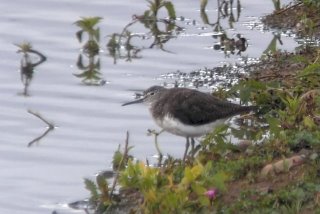
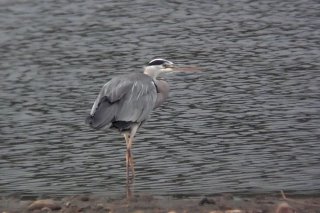
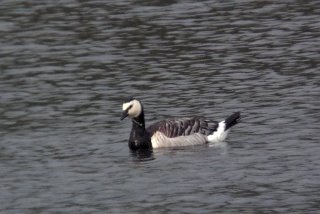
Along with the 'Blackwits' I found eight Green Sandpipers (one pictured top left), a Kingfisher, a Barnacle Goose (pictured above bottom, an irregular visitor to Brandon, almost certainly an escapee rather than a true wild bird), Great Spotted and Green Woodpeckers, and plenty of Lapwing and Grey Herons (above right) among the other regulars.
I also gave my new scope, an Opticron Mighty Midget ED, a good run out. Small enough to fit in my pocket, but with a clear wide 18x magnification, it is the perfect lightweight bit of birding kit. It also allows me to take snapshots without lugging loads of camera gear around - just a little Contax pocket camera held up to the eyepiece. Given the poor light, I'm very pleased with the efforts above.
These large waders are easily identified in the air by their long, straight bills and wide white wing bars. They had evidently been feeding on East Marsh Pool for much of the day, and were leaving as I arrived.



Along with the 'Blackwits' I found eight Green Sandpipers (one pictured top left), a Kingfisher, a Barnacle Goose (pictured above bottom, an irregular visitor to Brandon, almost certainly an escapee rather than a true wild bird), Great Spotted and Green Woodpeckers, and plenty of Lapwing and Grey Herons (above right) among the other regulars.
I also gave my new scope, an Opticron Mighty Midget ED, a good run out. Small enough to fit in my pocket, but with a clear wide 18x magnification, it is the perfect lightweight bit of birding kit. It also allows me to take snapshots without lugging loads of camera gear around - just a little Contax pocket camera held up to the eyepiece. Given the poor light, I'm very pleased with the efforts above.

30 July 2006
Spotted Flycatcher at Ufton Fields
After a successful early morning at Leam Valley, I pressed on to Ufton.
A good move indeed, because although things started quietly, I soon found a Spotted Flycatcher perched on a hawthorn bush near the IBM Hide.
This little grey bird is pretty non-descript in appearance, but somehow manages to convey bags of character. They are not at all easy to find in Warwickshire these days, so I have been fortunate to locate them in several parts of my patch in the last year or so - here at Ufton, at Offchurch, and in and around Cubbington Woods.
A good move indeed, because although things started quietly, I soon found a Spotted Flycatcher perched on a hawthorn bush near the IBM Hide.
This little grey bird is pretty non-descript in appearance, but somehow manages to convey bags of character. They are not at all easy to find in Warwickshire these days, so I have been fortunate to locate them in several parts of my patch in the last year or so - here at Ufton, at Offchurch, and in and around Cubbington Woods.
Little Ringed Plover at Leam Valley
Perfect patch birding - this morning I found three Little Ringed Plover on the scrape at Leam Valley.
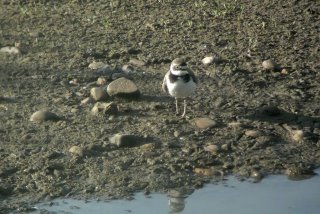
This is by no means a common bird, and certainly not one I have found here on my many previous visits. In fact, like the Little Egret I reported on a few days ago, it is a species I have only previously found in Warwickshire's major bird reserves - Brandon (where pairs have successfully bred in recent years), Kingsbury and Draycote.
Now here, at 7am on the outskirts of Leamington Spa, were three more. One female with two juveniles - a few days if not more apart in age, with one moving into adulthood and the other still bedecked in downy feathers. The female was every inch the concerned mother, calling constantly to ensure her youngsters stayed in close proximity. They, children through and through, remained content to feed non-stop, ignoring her rising-falling calls, and even failing to notice when she flew away all together. She was, of course, back within moments, unable or unwilling to leave these two little birds alone just yet.
These plovers were of course the result of a successful breeding attempt, perhaps somewhere else in the county, and were now starting to move on, preparing for the long journey south (because the Little Ringed Plover is a migratory bird, a summer visitors only to these shores).
These beautiful little birds were of course the highlight of the morning, but an honoury mention should also go to a Brown Hare I spotted at the far side of the scrape at the same time - I am always fascinated by these mammals, and delighted to see them.
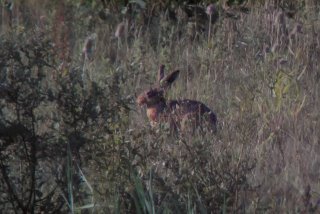


This is by no means a common bird, and certainly not one I have found here on my many previous visits. In fact, like the Little Egret I reported on a few days ago, it is a species I have only previously found in Warwickshire's major bird reserves - Brandon (where pairs have successfully bred in recent years), Kingsbury and Draycote.
Now here, at 7am on the outskirts of Leamington Spa, were three more. One female with two juveniles - a few days if not more apart in age, with one moving into adulthood and the other still bedecked in downy feathers. The female was every inch the concerned mother, calling constantly to ensure her youngsters stayed in close proximity. They, children through and through, remained content to feed non-stop, ignoring her rising-falling calls, and even failing to notice when she flew away all together. She was, of course, back within moments, unable or unwilling to leave these two little birds alone just yet.
These plovers were of course the result of a successful breeding attempt, perhaps somewhere else in the county, and were now starting to move on, preparing for the long journey south (because the Little Ringed Plover is a migratory bird, a summer visitors only to these shores).
These beautiful little birds were of course the highlight of the morning, but an honoury mention should also go to a Brown Hare I spotted at the far side of the scrape at the same time - I am always fascinated by these mammals, and delighted to see them.


27 July 2006
Little Egret at Wootten Wawen
A lunchtime stroll in Wootten Wawen (a Warwickshire village just outside Henley-in-Arden) found a Little Egret busily feeding on the edge of the manor house pond.
While still quite an unusual sight in Warwickshire, this elegant white heron-like bird is certainly becoming more common across the UK, even breeding in a number of coastal locations (I think Poole Harbour may have been the first). Over the last decade or so, the warmer climate seems to have helped this species to spread north from its former southern European strongholds.
It is still rare enough, however, to make it a rare lunchtime treat, with Wootten Wawen now only the fourth Warwickshire site in which I have seen a Little Egret (after Ladywalk, Brandon Marsh and Leam Valley).
While still quite an unusual sight in Warwickshire, this elegant white heron-like bird is certainly becoming more common across the UK, even breeding in a number of coastal locations (I think Poole Harbour may have been the first). Over the last decade or so, the warmer climate seems to have helped this species to spread north from its former southern European strongholds.
It is still rare enough, however, to make it a rare lunchtime treat, with Wootten Wawen now only the fourth Warwickshire site in which I have seen a Little Egret (after Ladywalk, Brandon Marsh and Leam Valley).
24 July 2006
Garden action from the Swallows and Starlings
There has been much frantic activity of late in the skies over Chez Hornet.
As the flying ants take to the air, so do the Starlings, post-breeding flocks of 200 or more birds determined not to miss out on a feast and convinced they are at least the equal of any flycatcher. It's an annual favourite of mine to watch them launch into the air, hover for a few frantic seconds while snapping at the ants, and then descend for a brief rest before repeating the whole process.

Meanwhile, the Swallows from the nearby farm have also bred successfully, and the skies over the house are filled with adults and juveniles alike. They often rest on the wires outside the front of the house, affording great views and generous photo opportunities.
With Swifts screaming overhead, House Martins chattering among them, and a persistent Wren or two in the garden, there's a veritable orchestra to enjoy at this time of year in the garden.
As the flying ants take to the air, so do the Starlings, post-breeding flocks of 200 or more birds determined not to miss out on a feast and convinced they are at least the equal of any flycatcher. It's an annual favourite of mine to watch them launch into the air, hover for a few frantic seconds while snapping at the ants, and then descend for a brief rest before repeating the whole process.

Meanwhile, the Swallows from the nearby farm have also bred successfully, and the skies over the house are filled with adults and juveniles alike. They often rest on the wires outside the front of the house, affording great views and generous photo opportunities.
With Swifts screaming overhead, House Martins chattering among them, and a persistent Wren or two in the garden, there's a veritable orchestra to enjoy at this time of year in the garden.

23 July 2006
Napton and Ufton - neglected corners
My local patch is basically defined by two waterways - the River Leam which snakes first north and then east from my home, and the Grand Union Canal, which runs directly east. Along the river to the north are some familar villages, such as Offchurch and Cubbington, and also the great Warwickshire woodlands of Princethorpe, Wappenbury and Ryton. The canal route makes its more direct route towards two outlying and much neglected treasures in my patch - Napton Reservoir and Ufton Fields.
Napton today was alive with fishermen, perhaps a dozen in all around this small body of water. Coot and Mallards aplenty were to be found, along with eight Great Crested Grebe and a couple of Common Terns - firsts for the patch. My favourite bird of the morning (a 6am start no less) was a Common Sandpiper which flew low from bank to bank, doing its best to avoid me but still proving unmistakeable, even at distance.

Ufton is a funny place, often quiet and yet so full of potential. Today there were few birds - some Mallards, a couple of Coot and Moorhen, but finally three Bullfinch and a Green Woodpecker to enliven the walk. But what magnificent dragonflies the place has - brilliant blue and huge like birds. The picture is a cheat - it's of an Emporer Dragonfly and I haven't got a clue if they have these at Ufton. But it looks right, and it certainly conveys the beauty of these creatures.
Napton today was alive with fishermen, perhaps a dozen in all around this small body of water. Coot and Mallards aplenty were to be found, along with eight Great Crested Grebe and a couple of Common Terns - firsts for the patch. My favourite bird of the morning (a 6am start no less) was a Common Sandpiper which flew low from bank to bank, doing its best to avoid me but still proving unmistakeable, even at distance.

Ufton is a funny place, often quiet and yet so full of potential. Today there were few birds - some Mallards, a couple of Coot and Moorhen, but finally three Bullfinch and a Green Woodpecker to enliven the walk. But what magnificent dragonflies the place has - brilliant blue and huge like birds. The picture is a cheat - it's of an Emporer Dragonfly and I haven't got a clue if they have these at Ufton. But it looks right, and it certainly conveys the beauty of these creatures.

21 July 2006
A hobby at Brandon
The Eurasian Hobby, Falco subbuteo, is one of my favourite birds - a slender-winged aerial acrobat which can twist and turn like a guided missile in pursuit of dragonflies, swallows, house martins and even swifts. It has brilliant yellow talons which stand out like neon lights against distinctive red 'trousers', and an equally prominant facial 'moustache'.
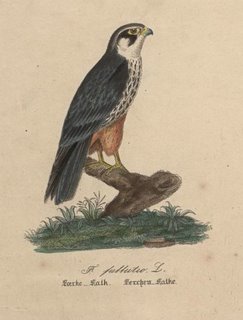
I've been lucky enough to see these beautiful creatures flying high over my garden, and also hawking for insects across lakes and reservoirs. But tonight I had the all-too-rare opportunity to study one at rest, sitting in a dead tree across from the Carlton Hide at Brandon Marsh. Only a few moments, but priceless nevertheless.
Not having my camera was an added advantage, because it meant I didn't spend those precious few moments fumbling for lenses or shutter release cables - instead I was able to just sit and enjoy. Instead of a photo, I think the picture above does a much better job of showing the beauty of this spectacular bird.

I've been lucky enough to see these beautiful creatures flying high over my garden, and also hawking for insects across lakes and reservoirs. But tonight I had the all-too-rare opportunity to study one at rest, sitting in a dead tree across from the Carlton Hide at Brandon Marsh. Only a few moments, but priceless nevertheless.
Not having my camera was an added advantage, because it meant I didn't spend those precious few moments fumbling for lenses or shutter release cables - instead I was able to just sit and enjoy. Instead of a photo, I think the picture above does a much better job of showing the beauty of this spectacular bird.

19 July 2006
Good butterfly intentions
Subscribe to:
Posts (Atom)
